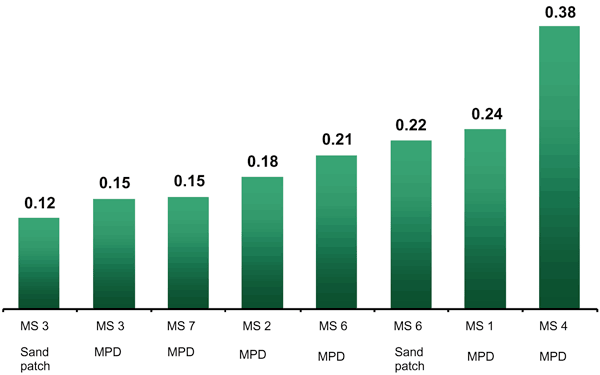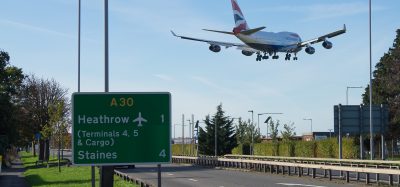Runway friction and strength research
Posted: 16 March 2005 | Adrian J. van Leest, Project Manager, CROW Research | No comments yet
This article from this Dutch research organisation outlines some of the recently finished and on-going projects dealing with airport pavement technology research in The Netherlands, including work on friction measurement devices and runway classification.
This article from this Dutch research organisation outlines some of the recently finished and on-going projects dealing with airport pavement technology research in The Netherlands, including work on friction measurement devices and runway classification.
Friction measuring equipment for airfield pavements
Various types of self-wetting continuous friction measuring equipment are used worldwide to capture runway surface friction. Inevitably, criteria for design objective level, maintenance planning level and minimum level are dependent on the type of equipment used. Even within apparently identical systems test results may be different due to variations in important test parameters such as test speed, tyre inflation pressure and water film depth. The rigid system of equipment labelled criteria hampers the introduction of new systems, suggesting that a more general approach would be more practical. This was the reason to start CROW’s multi stage project ‘Friction measuring equipment for airfield pavements’.
Stage one
Adequate runway friction between aircraft tyres and the surface of a runway is of great importance to conduct safe operations. Evidence from recent aircraft overrun and veer off accidents on wet runways show that the runway friction characteristics versus aircraft braking performance were often a contributing factor. Additionally it shows that the friction measurement and qualification of a runway is still a problem, as consistent prediction of runway friction values using friction testers still appears to be a challenge.
A study was carried out in which the tyre surface friction on wet pavements was examined with special focus on surface friction testers. Data and information were obtained from publications and private communication with worldwide specialists. In this study, potential relations between wet surface tyre-to-ground friction and surface texture measurements are identified and analysed. The major variables that influence surface friction measurements on wet surfaces are identified, such as surface texture. Furthermore an inventory of important international research on surface friction measurements and regulation on the use of surface friction testers was made.
Important conclusions of this desk study were that wet surface friction of pneumatic tyres cannot be correlated to a single surface texture parameter, that a formal international standard for the certification of surface friction devices does not exist, that lack of suitable methods for measuring the surface microtexture has limited the success of developing methods for correlating friction devices on wet surfaces and that methods for the harmonising of friction measurements with different equipment to a common calibrated index (such as the International Friction Index IFI) revealed shortcomings, which will limit the success of these methods.
Stage two
Airfield runway friction measurements are used to detect any deterioration in skid resistance and determine if maintenance is needed. A large number of different friction measuring devices are available for this purpose, which all have different operating modes, different tyres, and are tested with a wide range of tyre inflation pressures. As a result all of these devices can measure different friction values on the same surface. Many attempts have been made to correlate the output of different devices, with only limited success. There are many variables that affect the measured friction values. Some of these variables can be controlled and others not. These uncontrolled variables contribute to the random uncertainty in the output of a friction measuring device.
The Engineering Science Data Unit (ESDU) company developed a statistical method for relating the braking performances of aircraft and friction measuring devices in naturally wet surface conditions. This method takes the random uncertainty in the output of a friction measuring device into account. The ESDU method has been successfully applied to friction measurements made on naturally wet surface conditions, but had not yet been applied to correlate the output of friction measuring devices that operate in a self-wetting mode, used widely for maintenance purposes. Concern existed then as to whether the ESDU method could handle self-wetting friction measuring devices. This prompted actions to be taken to evaluate if the ESDU method could be used to correlate the output of friction measuring devices with a self-wetting mode on various airfield runway surface types. For this purpose the current data of five friction measuring devices was analysed, and the devices then tested on surfaces with a large variation in macro texture depths.
The results of the evaluation showed that the ESDU can indeed be used to correlate the output of friction measuring devices that are operated in a self-wetting mode. This opened the road to comparing measurements of various friction testers on several types of airport pavement surfaces.
Stage three
Following this approach, an investigation into the exchangeability of friction coefficient data and texture data captured by various self-wetting friction measuring devices for routine maintenance friction monitoring on Dutch airfield pavements was conducted.
This culminated in a correlation trial for eight self-wetting friction measuring devices held on test sections at Air Force Base De Peel and on a road nearby in September 2003. 300m long test sections with different macrotextures were selected. The macrotexture was measured with a texture laser and expressed in Mean Profile Depths ranging from 0.6mm to 1.6mm. During the friction measurements, the test sections are travelled at test speeds of 40km per hour, 65km per hour and 95km per hour using three replicate runs. The participating friction measuring devices possessed different operating modes, different tyres, and are tested with a wide range of tyre inflation pressures. As a result all of these devices measured different friction values on the same surface.
The test results are analysed via the ESDU method. The project shows that this statistical method can be used to correlate the output of friction measuring devices that are operated in a self-wetting mode on airfield runway type of surfaces. The method takes the random uncertainty in the output of a friction measuring device due to uncontrolled variables into account. Texture data play an important role in the analysis of the data.
Conclusions and recommendations have been drawn for future testing (in September 2005) and for drafting calibration procedures and admission protocol for self-wetting friction measuring systems new on the Dutch market of airfield pavements.
Figure 2 shows that the MS-4 has the highest random uncertainty and the MS-3 the lowest. This means that the MS-4 is more sensitive to uncontrollable circumstances than the other devices. It is a device dependent property not indicative of reliability or quality of measurement. The trial was not set up to compare qualities of the various devices, but to correlate the operational Dutch devices.
The report of this phase presents the set-up of the correlation trial and the analysis of the test results by means of the ESDU method. This phase forms part of the multi stage CROW project ‘Friction measuring equipment for airfield pavements’.
PCN Runway Strength Rating
United Nations member states are required to evaluate and publish the strength of airport pavements using ICAOs ACN-PCN system. The method concentrates on classifying the relative damage of aircraft. ICAO foresees that each pavement authority will define a Pavement Classification Number (PCN) by whatever means is considered suitable. Comparison of the PCN with an aircraft’s published Airport Classification Number (ACN) will show which aircraft can use a given pavement safely, without load bearing failure or undue damage to the structure. The ACN is a relative number which expresses the relative damage caused by an aircraft and can be calculated using a prescribed ICAO method. By contrast with ACN, PCN assignment is not fixed by a prescribed technical method.
Under CROW’s instigation a study into PCN assignment has been conducted. The objective of the study is twofold; first to clarify ICAO’s ACN/PCN reporting system for civil airports, presenting the status on ACN/PCN, and secondly to investigate the PCN assessment methods currently utilised by member states. The investigation has led to a number of recommendations which should result in a standard method for PCN assessment for usage within The Netherlands and/or NATO practice. The assembled information can also be used by NATO nations or be prescribed by a nation’s Civil Aviation Authority to arrive at realistic and comparable PCNs.
The system does not dictate a specific design method for PCN assignment. For states or individual civilian airport authorities, technical PCN values are often determined as an extension of existing national pavement design and evaluation technologies. As a consequence, technical PCNs can vary depending on the evaluation method used. However, ICAO does relate PCN to the pavement life and the annual volume of traffic, implying a pavement to have a variable PCN as a function of the desired structural pavement life. Therefore the PCN functions as a managerial pavement tool, its selection not only dependant on the technical value, but is largely dependant on the business decision.
This does not license an airport to assign any desired PCN to a pavement. ICAO does give guidance on how to assess a pavement PCN and there must be a relation between assigned PCN, the traffic mix that uses the pavement, and structural pavement life. Should a higher PCN be assigned to a pavement, the structural life will be shortened as a consequence.
For NATO purposes, the ACN-PCN system is used to compare bases, manage pavements and plan missions. The PCN is assigned based on a number of passes of a critical aircraft, which can vary per NATO nation. As NATO nations provide additional information to the PCN code with respect to the evaluation aircraft and number of passes used, a common denominator is found in the U.S. PCN evaluation method. NATO nations consider this a transient method while progressing to Layered Elastic Analysis
Layered Elastic Analysis
As pavement design and evaluation technology evolves using Layered Elastic Analysis and calibrated failure criteria derived from material testing and full-scale pavement tests become available, pavement prediction performance, design and technical PCN improve. Nevertheless it should be borne in mind that, although layered elastic based procedures exist, a considerable amount of engineering judgment is still required. In order to harmonise and arrive at reproducible and realistic PCNs, an uniform set of pavement transfer functions (performance models) and material characterisation (properties) are required. Since these are highly dependant on the local materials used, this must be addressed on a national level.
As a consequence to the fact that ICAO does not prescribe or dictate a specific method for the PCN assignment, the derived PCN calculation result is likely to vary to a great extent. Therefore harmonisation of the degrees of freedom in the analytical methods to be used is thought necessary. Harmonisation is needed for standardisation of the pavement models, the calculation steps, the assessment or selection of material characteristics (transfer functions), the structural pavement life, the design criteria in relation to the true pavement damage, reliability concept as well as traffic and wander. Since sophisticated design tools already exist, CROW will concentrate on harmonisation rather than further developing software which is already available in the public domain or as proprietary software. Eventually it leads to the guidance for PCN assignment in The Netherlands. This guidance can be used in The Netherlands by airport pavement engineers or be prescribed by national Civil Aviation Authorities to arrive at realistic pavement designs and comparable PCNs.
CROW
CROW is the non-profit Dutch technology platform for transport, infrastructure and public space which allows airports, contractors, consultants, suppliers and educational institutes to collaborate in pursuit of common interests through the design, construction and management of (airport) pavements and other traffic and transport facilities.
A series of relevant reports written in English and downloadable free from CROW’s website: www.crow.nl/engels. The organisation will also be hosting a workshop on airport pavement technology in May in the Netherlands.


Figure 1: Participating friction measuring devices (measuring systems)


Figure 2: Coefficient of variation tested friction devices (Measuring Systems)
Disclaimer
CROW does not endorse products or manufacturers. Trade or manufacturers’ names appear in this paper only because they are essential to its objectives.
Adrian J. van Leest
Adrian J. van Leest is project manager at CROW. The author is presently dealing with topics in the field of airfield pavements, road pavements and railway constructions.
The International Airport Summit is open for registration!
Date: 19 – 20 November 2025
Location: JW Marriott Hotel Berlin
At our flagship event of the year, we will dive into the future of airport operations, with expert-led sessions on passenger experience, innovative smart technologies, baggage handling, airside operations, data, security, and sustainability.
This is where global airport leaders come together to share insights, challenges, and real-world solutions.
Limited complimentary passes are available for eligible professionals – first come, first served!

















